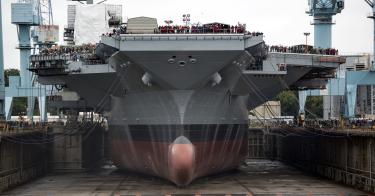In the flurry of news stories about munitions production and aid to Ukraine, the closure of four dry docks at a U.S. Navy shipyard six weeks ago went largely unnoticed. This development, however, will create massive problems for the Navy’s submarines and aircraft carriers, the industrial base, and national defense as a whole.
Why did the Navy close three dry docks at Puget Sound Naval Shipyard and another at the nearby Trident Refit Facility in Bangor, Washington? Seismic concerns. These dry docks lie on a fault line, and the Navy determined that the risk of damage to ships using these facilities outweighed the risk of more maintenance delays caused by shutting them down.
How bad is it? A Navy report concluded that the earth under one dry dock at Puget Sound may be “subject to liquefaction in a seismic event.” In other words, there is a good chance that the dry dock—ship and all—could be sucked into a sinkhole during a significant earthquake.
The U.S. has only four public shipyards: Puget Sound and Pearl Harbor on the west coast, and Norfolk and Portsmouth on the east. These yards are responsible for maintaining the Navy’s nuclear-powered fleet, i.e., aircraft carriers and submarines. Between them, these shipyards had 18 dry docks. Now four of them (22 percent) are out of commission.
>>> The U.S. Navy Must Grow To Confront China (but We Must Study Past Sins)
This will hurt the Navy’s ability to maintain and service their fleet. Currently, 36% of the Navy’s attack submarine fleet is either in—or waiting for—maintenance. With four dry docks offline, these numbers will likely get worse.
The closures also create extra risk for aircraft carriers. Carriers require especially large dry docks, and dry dock #6 at the Puget Sound Naval Shipyard was the only dry dock on the west coast certified for nuclear aircraft carriers. With its closure, any nuclear aircraft carrier needing dry dock-level repairs or maintenance will have to be relocated all the way to the east coast, to the only remaining dry dock able to accommodate them.
The seismic assessment that led to the closures came as part of the $21 billion Shipyard Infrastructure Optimization Plan (SIOP). SIOP began in 2018 as an attempt to address the increasingly poor conditions of the nation’s centuries-old shipyards.
All four Navy shipyards suffer from decades of underinvestment and neglect. They have too few functional dry docks, and their facilities and capital equipment are old and poorly configured. The SIOP involves re-engineering dry docks, reconfiguring facilities in the shipyards, and replacing capital equipment (like cranes). The plan was very precisely timed, and subsequent delays in implementing the plan are already taking their toll on ship maintenance schedules.
Ironically, the decision to close the four dry docks as a result of the seismic assessment will make completing the rest of the SIOP’s planned investments that much more difficult. The plan already required the Navy to close dry docks for years-long renovation periods. With four more dry docks closed, it is unclear how the Navy can make up for the lost maintenance capacity.
>>> This Ugly Dispute Over Amphibious Warships Didn’t Have To Happen
And while these closures are bad enough in peacetime, they make the idea of war in the Pacific that much more alarming. The lack of maintenance and repair capacity at public shipyards would severely restrict our ability to repair battle damage and keep aircraft carriers and submarines in the fight.
Without the basic infrastructure needed to support American naval interests, it is hard to say whether the Navy would be able to provide adequate defense capabilities if called upon to wage war. This is especially worrisome as China continues to expand naval influence in Southeast Asia and beyond. The Heritage Foundation’s Index of U.S. Military Strength finds the Navy fleet is not sufficient to counter China. But even if the U.S. had its congressionally-mandated 355 manned warships, all the best submarines and aircraft carriers in the world will be useless if the U.S. cannot service, maintain, and repair them.
The sudden closure of Navy assets in Puget Sound and Bangor should awaken Congress and the White House to this overlooked, but very real naval crisis-in-the-making. Unfortunately, the turmoil in Washington today makes it hard to capture the attention of distracted policymakers.
The U.S. now has the fewer public shipyards than any time since the end of the Second World War. Whether we re-acquire previously owned public shipyards or build a fifth, increasing naval infrastructure—including dry docks—is essential to maintaining a Navy that can defend the United States.
This piece originally appeared in RealClear Defense




